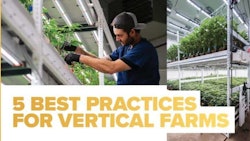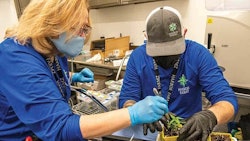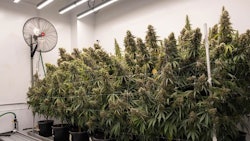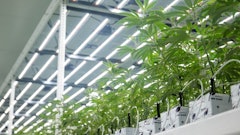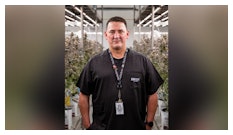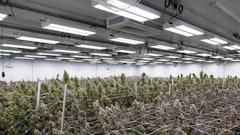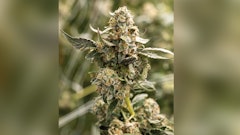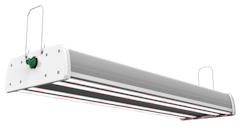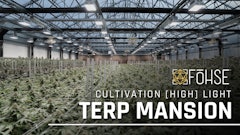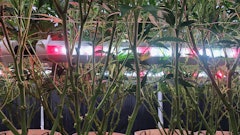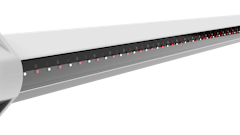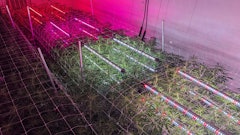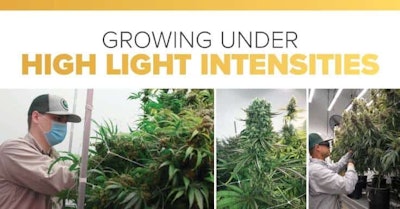
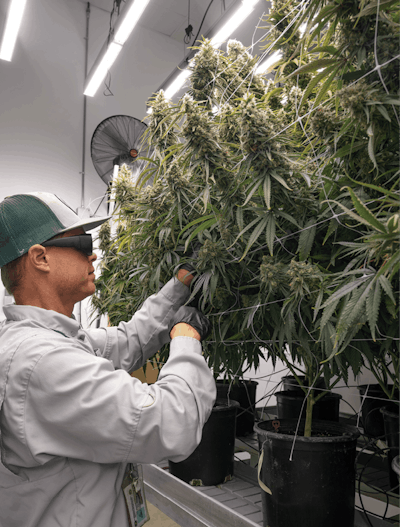
For cannabis growers operating in greenhouse or indoor cultivation facilities, finding the perfect lighting strategy is an ongoing quest. Advances in lighting technology continue to illuminate the complex relationship between cannabis and light. For many growers and researchers, the emphasis has shifted from light color or spectral quality to light intensity—specifically, high light intensities that go beyond sunlight intensity.
Defining High Light Intensity
To understand what constitutes high light intensity, Mitch Westmoreland, Ph.D. candidate and Research Associate at Utah State University’s Crop Physiology Lab, starts with simple reference points—like the sun.
Photosynthetic photon flux density (PPFD), measured in micromoles of photons per square meter per second, remains the standard of measurement for light intensity in growing environments. Westmoreland describes PPFD as an instantaneous value reflecting how much photosynthetically active radiation (PAR) hits the leaf each second.
In Westmoreland’s experience, he’s found many cannabis growers happy to hit 700 to 1,000 PPFD. For perspective, he puts peak outdoor light intensity on a midsummer day at 2,000 PPFD.
Jason Sanders, head of cultivation at Texas Original Compassionate Cultivation (TOCC), estimates the average cannabis facility grows at 900 to 1,000 PPFD during flower. TOCC grew in that range before beginning research on spectral quality and light intensity in early 2020 in partnership with Fluence by OSRAM.
“If you can get above 2,000, you’re really pushing it,” Westmoreland says. “That’s a very high light intensity.” But he cautions that photosynthetic rates level off dramatically when PPFD exceeds 2,000 micromoles.
Exploring High Intensity Limits
TOCC’s light intensity trials with sole source lighting have involved PPFDs from 1,000 up to 2,500—an upper limit determined mainly by the facility’s power capabilities.
“We maxed out our load,” Sanders says. “We learned that the best value was around that 1,800 micromole level for cannabis. As we start increasing from 1,000 micromoles up to 1,800, we saw about a 1% increase in yield for every 1% increase in light intensity. That started to diminish from 1,800 to 2,500.” While yield increased up to 2,500 PPFD, it was more bell curve than linear beyond 1,800 PPFD.
The biggest surprise? “It was amazing to see the plants take the light,” Sanders says. “I would have thought that we would have seen some type of phototoxicity—some kind of leaf curl, burning, something—but the plants were able to handle it.”
Although cannabis is a high-light crop capable of achieving high photosynthetic rates at high light intensities, Westmoreland says there’s a ceiling to how much light any plant can take.
“Physiologically, plants can only handle so much in terms of using that energy for photosynthesis, and so they have to come up with ways to dissipate that energy,” Westmoreland says.
When light overwhelms a plant’s photosynthetic machinery, damage can result. Researchers are still discovering how cannabis handles stressors that come with high light.
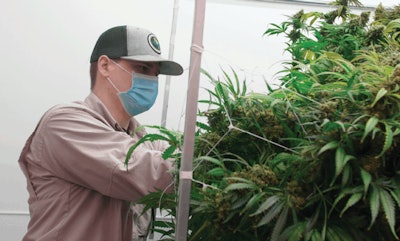
Interacting with Spectral Quality
TOCC’s next study is focused on effects of different light spectra at various PPFDs. The best yields to date have been with Fluence’s broad-spectrum R4 lighting. Type 1 (high-THC, low-CBD) cannabis grown at 1,500 PPFD under R4 showed 17% higher yields in dry bud weight as compared to R6. Higher fractions of red light (corresponding with higher R numbers) tracked lower yields for the company.
Westmoreland and Sanders report photobleaching—bleached, white flower tips—at higher light intensities with test treatments where more red is added to the spectra. For TOCC, no photobleaching was observed under R4 spectrum at PPFDs of up to 2,500 micromoles/m2/s.
“Photobleaching seems to be an interaction between light intensity and light quality,” Westmoreland says. “It seems that a higher fraction of red makes plants more prone to photobleaching. It also tends to happen just at the high light intensity, regardless of the fraction of red.” He suggests photobleached tips are most likely above 60% to 70% red.
But Westmoreland also notes USU testing shows photobleaching does not lower cannabinoid concentration or affect yield. “It’s just a cosmetic thing,” he says.
Moving Beyond Biomass
Westmoreland says USU hasn’t yet seen good evidence that cannabinoid concentration increases in proportion to yields under high light intensities. “But it does take energy to make cannabinoids. It takes energy to make terpenes. The source of that energy is light. So, it’s not completely ridiculous to think that more light also means more cannabinoids,” he says. “The gray area there is we don’t necessarily know what the ceiling is yet.”
Exploring that relationship is now a focus for USU researchers. “We have sufficient evidence that spectral quality might have a small impact on cannabinoid concentration and morphology, but the bigger question is what does light intensity do?” Westmoreland says.
A new state-of-the-art, 10-chamber, canopy gas exchange system may help with answers. “We can look at photosynthetic responses in real time to the different light intensities, and we can also relate that to yield and cannabinoid concentration at the end of the life cycle,” Westmoreland says. “We’re also looking at the interactions with high light and nutrition and high light and temperature, because all of these things interact and affect yield.”
Adapting Lighting Types
When TOCC first began lighting studies, the 2,000-square-foot facility grew under high pressure sodium (HPS) bulbs. An interest in LEDs and the opportunity to conduct lighting trials and see LED benefits led to change, and TOCC now runs all LEDs with dimmable switches.
“I think the greatest challenge for growers now is being able to hit those high PPFD numbers and still have the environmental parameters still dialed into the grower’s setpoints,” Sanders says.
In HPS grow setups, growers will need to increase their number of lights and ramp up HVAC systems to handle the added heat load. “With the new technology of LED, then you can get to those light levels without having the heat problems,” Sanders adds.
Westmoreland agrees that extra thermal load is an obstacle for HPS growers at high light intensities: “That’s where LEDs become really nice. They don’t have quite as much thermal radiation, and the thermal radiation they do produce goes up, away from the plants. So, you can run these lights much closer to the canopy and potentially get a higher light intensity.”
_fmt.png?auto=format%2Ccompress&fit=max&q=70&w=400)
Establishing Best Practices for High Light
When TOCC started growing under high light, plants grew in peat-based media in No. 5 pots. It is now trialing 6x6 rockwool cubes. Sanders feels the larger root zone offered a buffering effect at high light intensities; smaller root zones are much less forgiving. “You’ve got to really be on your A-game,” he says.
By growing under higher light intensities, the plant responds differently to its surrounding environment. With peat, TOCC increased the EC in its normal feed program to accommodate high light in flower. With rockwool, the team runs increased phosphorus at the beginning of flower, then drops back to normal for the rest of the flower cycle.
Sanders also increased TOCC’s veg cycle from two weeks to three, to allow more maturation before rockwool-grown plants hit high light. Propagation runs at 150 to 200 PPFD. In veg, that jumps to 350 to 550. From veg to flower, Sanders slowly increases intensity from 550 to 1,800 PPFD during a week-long photoacclimation that kicks off eight weeks of flower. He’s also increased CO2 enrichment levels to between 1,000 and 1,200 ppm.
Westmoreland reminds growers to have a light meter and use it. “The human eye is a terrible light meter, especially at high light intensity,” he says. He suggests monitoring throughout the day over the course of a few weeks, especially if you grow in greenhouses that experience light fluctuations. From there, expect water demand to increase under high intensity, and adjust nutrient solutions to accommodate the change.
Looking Beyond PPFD
Westmoreland encourages growers to look at daily light integral (DLI, the amount of PAR light hitting a designated area over 24 hours), not just instantaneous PPFD.
“If it’s raining outside, you’re not really interested in how many raindrops are falling at any given moment. What we’re interested in would be accumulated total. That’s the exact same thing for plants,” he says. “We can think of photons as raindrops. We’re not necessarily interested in the instantaneous number of photons hitting a crop or a leaf at a given time, but we’re interested in the long-term accumulation of those photons. That’s ultimately what’s contributing to the yield.”
Westmoreland explains that outdoors in Logan, Utah, where he’s located, the maximum DLI in midsummer is about 60 moles per meter squared per day. (For context, 1 mole equals 1 million micromoles.)
While outdoor light intensity varies throughout the day, controlled environments can run constant light intensity all day long. “You can get daily light integrals that are approaching 100, depending on how hard you push your plants. That’s what I would consider to be high light intensity in terms of integrated over the whole day,” he explains.
As growers advance in understanding optimal light intensities for cannabis, Westmoreland says the total amount of light accumulated over the entire crop is key.
For Sanders, it’s an exciting time. “I think that it is really awesome that we’re in a time period now where we can look at kind of a light recipe here. We can dial in intensity, so we can start at low PPFDs and then ramp them up as these plants get into flower and really optimize it,” he says. “As a grower, it’s awesome to have this extra tool in the toolbox now.”








